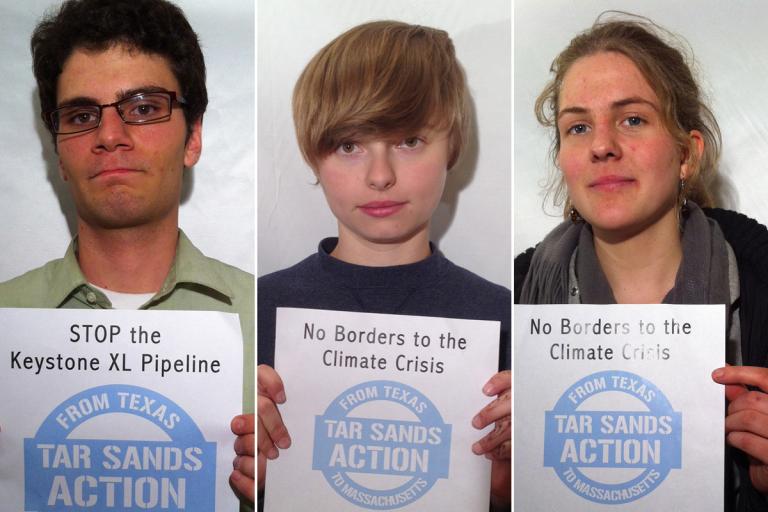Two months ago, my report “Naming the Problem: What It Will Take to Counter Extremism and Engage Americans in the Fight Against Global Warming” [PDF] was posted online (along with an important companion report, “The Too Polite Revolution” [PDF], by journalists Petra Bartosiewicz and Marissa Miley). These reports probed what happened with the big push for cap-and-trade legislation in 2009 and 2010, and mine used the results of months of research to place this episode within the larger political trends that have been playing out in U.S. politics in recent years.
As a scholar of U.S. politics, I am accustomed to analyzing social movements as well as efforts to enact big policy reforms, and I always look forward to learning as much from debates about my writings as from the original research. Nevertheless, I was surprised by the sudden and intense debate my report helped to kick off.
The whole report was accurately summarized in the first major news article on it, by Suzanne Goldenberg at The Guardian, but the editors assigned her article a headline and teaser that hit a sore spot: “Climate Change Inaction the Fault of Environmental Groups, Report Says: Academic Paper Largely Clears President Obama of Blame Over Failure to Pass Climate Legislation Through Congress.” No matter that my report pointed to Republican extremism as the problem that had to be “named,” faced, and effectively countered. No matter that it called for forward-looking strategies and hardly used the word “blame” at all (except in brief accounts of how various wings of environmentalism fingered each other for the cap-and-trade shortfall).
Almost instantly, Cap-and-Trader Joe Romm at the Center for American Progress called troops into battle, going after me for doing a 145-page “opinion piece” rather than a properly “refereed” research article (an odd accusation coming from a blogger). When comments at CAP’s ThinkProgress blog deteriorated into tagging me as a plant by climate-change deniers, I left the Democratic Party’s “progressive” think tank to its own circular firing squad and focused on learning from discussions at my talks and from much more substantive debate at Grist and other media outlets.
Dozens of emails arrived from environmental activists and funders and participants in the 2009-10 congressional maneuvers, alerting me to additional facts and thanking me for encouraging a necessary strategic reexamination. I have also followed early steps by the reelected Obama administration and press coverage of the newly introduced Boxer-Sanders climate bill and the big D.C. rally against the Keystone XL pipeline. As I continue to learn, here are some of my reflections on key issues:
The danger in treating 2009-10 as a close call
Some cap-and-trade supporters still see their 2009-10 push as a near miss that would have succeeded with just a few lucky breaks or tactical improvements. Joe Romm fiercely insists that there were 51 votes in the Senate and that President Obama could have thumped his chest and forced Congress to accept “reconciliation rules” setting a majority threshold and avoiding filibusters. Not only is there no evidence for this fantasy, but one insider wrote to alert me to the fact that, in April 2009, more than two dozen Democrats joined in voting for a GOP-sponsored bill that explicitly ruled out use of the 51-vote threshold for climate change legislation. This was a much stronger and more formal step than the usual process by which centrist Democrats take pro-reform stands in public but, behind the scenes, lobby Democratic Senate Leader Harry Reid against either reconciliation (51-vote) rules or filibuster reform.
Many Midwestern and other Democrats do not want to be put on the spot by a majority rule on big issues such as cap-and-trade where they are cross-pressured. Their reluctance must be changed in future legislative battles, and the key to that will be increased pressure from citizens in their districts and states. If we are to pass climate legislation, Democrats will have to hold a Senate majority, and their majority will have to remove or weaken the 60-vote threshold.
Romanticizing 2009-10 as a near miss may seem harmless enough, a form of self-reassurance by cap-and-trade supporters who misdiagnosed the larger political terrain. But such misdiagnosis actually encourages the sort of minimal recalibration signaled in Environmental Defense Fund VP Eric Pooley’s remark that sometimes a loss points not to a bad game plan, but to poor execution. I am a well-informed NFL fan, and as I explain in a recent Foreign Policy rejoinder to Pooley, the overwhelming evidence reveals that the U.S. Climate Action Partnership — a coalition of business and environmental leaders that pushed cap-and-trade — had a bad game plan, not just a few dropped passes in the fourth quarter. After losing games or seasons that fall short, good NFL teams do clear-eyed post-mortems and create new game plans and remake their team’s composition. Would-be carbon cappers can do no less.
The need for environmental groups to get out of their comfort zones
As leaders of various kinds of environmental groups debate my report, a lot of what seems to be going on is mutual finger-pointing and blame-shifting along with efforts to attract more funding to particular organizations. In political and social movements, an ever-present danger is substitution of organizational maintenance for effective strategizing about how all forces together can push toward the real goal. Especially for organizations with big paid staffs, it is very easy to believe that what will attract that next grant will also further the substantive reform goal. But will it — and who will orchestrate true strategic reevaluations?
A number of journalists who report on environmental politics have remarked to me that, in their assessment, this is a very internally divided field of organizations. My report calls for investments in far-reaching inter-organizational alliances and networks that would allow Beltway and state and local groups to pull together more effectively in any future push for national carbon-capping legislation. It takes time to build such alliances, but so far I see few signs of efforts to do so. It cannot be done by a few big players who write legislation in advance and simply invite others to support what they set forth. Nor will taking polls and tweaking messages to reach unorganized mass audiences accomplish what is necessary. Building broad citizen understanding and support has to proceed hand in hand with knitting together far-reaching organizational alliances to push for legislation all can get behind.
The importance of reaching Americans beyond the upper-middle class
Now that President Obama has been reelected and some new supporters made it into the Senate, established environmental organizations are happily reveling in the president’s new willingness to give speeches about global warming and signal that he will support regulatory steps through the Environmental Protection Agency and other executive bodies. One can almost hear the sigh of relief that, now, most professionally run organizations can go back to doing what they do best: writing reports and recommending regulatory actions. That has been the well-worn groove of action since the 1970s. Throw in occasional chain-yourself-to-fences demonstrations and short visits to jail, and we’ll be on a roll, global-warming reformers think.
I can understand the happiness at new openings, and there is good evidence that EPA regulatory steps under the Clean Air Act, coupled with economic shifts toward the substitution of natural gas for coal, can make a difference in reducing dangerous emissions. In fact, environmental organizations that have long championed regulatory actions rather than cap-and-trade legislation with a lot of free permits and weak standards may be proven correct in this period. Such mainstream professional environmental organizations will be tempted to say goodbye to efforts to accommodate polluting businesses (which is what much of the 2009-10 effort was about).
But I also think that all forces concerned with speeding America’s transition to production and use of cleaner sources of energy need to take this period to do more than push the EPA to regulate carbon energy polluters. At the same time, reformers should be building broad center-left organizational alliances and broader public support to prepare for the next opening for possible congressional action, perhaps in 2017. To be effective, these inter-organizational alliances will have to stretch far beyond environmental activists, reaching community groups, unions, churches, organizations of healthcare providers, women’s organizations, and many other kinds of associations with deep roots and actual constituents. USCAP No. 2 is not going to cut it next time. Nor will expert reports to the EPA and the occasional demonstrations of tens of thousands of avowed environmentalists.
Why not? Because, like it or not, environmentalism has long been primarily a cause of the educated upper-middle class in the United States, and it remains largely populated by experts and activists from that relatively privileged, non-majority class background (including university students headed for that stratum). Yet needed global-warming reforms go far beyond traditional environmental regulations, and they will require acceptance, and some enthusiastic support, from the majority of ordinary American workers and families. Almost all families now use carbon-intensive forms of energy to light and warm their homes. Because these families have not seen real wage increases in decades, they are extremely sensitive to even modest price increases in life necessities.
The climate-change deniers and opponents of carbon limits understand this, and they are well prepared to scare ordinary American families with claims that global-warming regulations will increase living costs. The enemies of any kind of carbon limits will tell ordinary Americans that “elite” environmentalists are about to shaft them by “taxing” their energy use. Climate reformers will need to be aggressive in telling regular Americans that, no, they will receive rebates more than equal to their higher energy costs under carbon-capping legislation.
Rebates of revenues raised from carbon taxes or caps must become central features in legislative pushes, because otherwise it will not be easy to get the message out. The recently introduced Boxer-Sanders bill, for example, includes modest monthly rebates to citizens as well as carbon taxes and investments in clean energy, but all that got highlighted in media reports were the taxes and the investments. Going forward, a simple carbon tax and “green dividends” approach may be best, with 75 to 80 percent of the revenues raised devoted to highly visible checks sent annually to each citizen. The advantage of this approach is that it would be simple to administer and explain, and the rebates would be front and center — impossible for media reporters to overlook, and impossible for voters to overlook.
So far, I find the global-warming movement to be tone-deaf to valid majority concerns about increased costs. Snippets here and there tell the story. At a recent Harvard event, a well-intentioned proponent of higher carbon prices remarked that they would “only raise electricity prices by $25 a month,” not much at all in her eyes. From the perspective of the upper-middle class in Cambridge, Mass., this is indeed a modest cost. But, of course, for most families that increase would be way too much to accept — and they would listen to right-wing attacks on global-warming regulations that threatened price increases of that much or more. Likewise, at the recent, inspiring D.C. rally against the Keystone XL pipeline, a blogger did an (unscientific) snap poll among attendees, asking them to choose among various things that would “give up” to pay for greenhouse gas regulations. By a large margin, the global-warming demonstrators were reported to be willing to delay Social Security benefits and raise the U.S. retirement age. Of course, this sounds like a harmless step to professionals who work at desks. But do they realize that virtually all of the increase in longevity in the United States in recent decades has gone to white-collar and professional people, while Americans who work on their feet all day, or lift things for a living, have not enjoyed any increase in life expectancy? How will the majority feel about being asked to work at physically taxing jobs much closer to the point of death to pay for global-warming remedies? Asking the question answers it.
For me, the bottom line is simple. Global-warming reformers must stop being blind and tone-deaf to the real-life circumstances of typical American families in an era of astonishing socioeconomic inequality. The current fashion is to suppose that severe weather emergencies will, in and of themselves, prompt most Americans suddenly to support governmental actions with real bite. I really doubt this. Severe weather events are not self-interpreting; they are most likely to be understood as signs of global warming by educated people who already believe in the reality of this threat. Beyond that, humans have, for thousands of years, grown accustomed to adjusting to weather events and trends. People just devise work-arounds and truck on, and that is what will happen if global-warming reformers cannot do better than cheer for speeches by President Obama that point to weather emergencies.
Anti–global warming policies that ordinary Americans can understand, policies that deliver concrete benefits to ordinary families, plus the construction of far-reaching networks of allied organizations able to push Congress — these are what it will take to pass carbon-capping legislation next time.
—–
Read responses to Theda Skocpol’s original report from Bill McKibben, Eric Pooley, Joe Romm, Mark Hertsgaard, and Mike Tidwell, plus three (count ‘em: one, two, three) from Grist’s David Roberts.
—–




